ORCAdsc MOB alarm, the real deal?
I believe you’re looking at the first DSC-based MOB alarm available in the U.S. It’s BriarTek’s ORCAdsc, and it sells for $275 per alarm (a reasonable seeming price that got Lenny’s attention). It automatically activates when submerged in salt water, and a regular DSC VHF radio is all you need to get alarmed onboard (which is what I’ve always liked about using DSC for MOB). The BriarTek site doesn’t list this new product yet (coming soon), but you will learn how serious the company is about MOB electronics. The ORCAdsc materials I have here, including the manual, also suggest a carefully designed and built device, though it turns out that DSC MOB doesn’t work exactly like I thought it would…
Apparently the RTCM 11901.0 standard for Maritime Survivor Locating Devices mandates that MSLDs can only alarm an associated vessel, not all vessels within VHF range. Hence, instead of just sending out a standard DSC Distress alarm, the ORCAdsc uses a pre-programmed BriarTek Group MMSI that you must program into your boat’s VHF (not hard). You can also program your own Group MMSI into the alarm — which might make particular sense if, say, you’re part of an offshore racing fleet — though it looks like a tedious process involving many taps of the magnetic antenna tip seen below on the sensor marked Program. That tip is also used to test the alarm or to turn it off.
The photo below (on which I overlaid the unit’s backside) also indicates ORCAdsc’s petite size (just 3.5-inches tall and 3 ounces light), and how it can be worn as a pendant, thus submerging the water sensors while keeping the antenna at least somewhat exposed to the air. The ORCAdsc also has a built-in strobe and a 121.5 mHz transmitter that can be honed in on by most any SAR vessel or aircraft (or your own boat if you have the needed direction finder). I don’t know much about the recently discussed Navicom RT-650 MOB because it’s not sold here, and the Mobilarm VPIRB, discussed here in 2008, never got to market here either, and is now hard to find on the Mobilarm site. Might the ORCAdsc be the real deal?


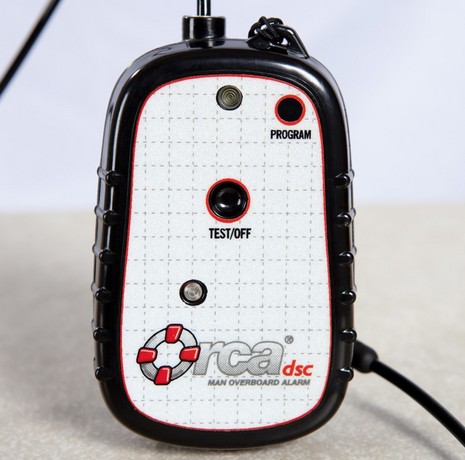
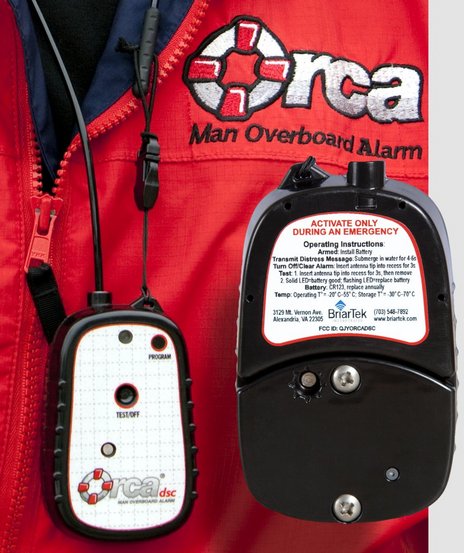
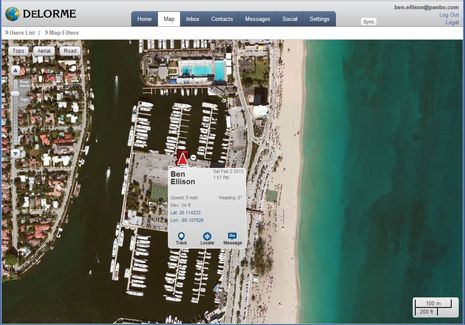
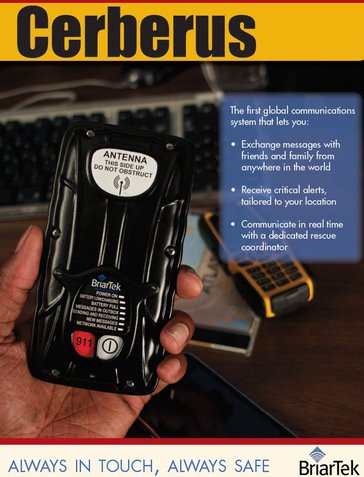

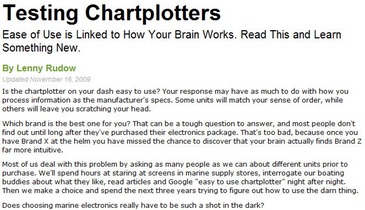








Would that still attract the attention of the USCG?
Would the USCG then, attempt to hail the associated vessel?
If nobody responded, would the USCG query the associated vessel VHF radio for its lat/long ?
Assuming a response, with a near matching lat/long, would the USCG look to cover the possibility that a single handed sailor fell off their boat ?
With the push of a button, could the USCG Rescue 21 system retransmit the MOB alarm intended for the associated vessel, as a typical DSC alarm that all ships could see?
Dan, I don’t know much about the details of Rescue 21 capabilities (I should investigate), but think that the ORCAdsc is meant for self rescue operations by crewed boats. The VHF transmitter power is 100 mW, for instance, with an expected range of one nautical mile. Of course, someone on the boat can use 25 watts to call the USCG and nearby vessels, with or without DSC.
The homing beacon on the ORCAdsc, incidentally, is listed at “up to 100 mW” with a range to ships of 5 nm, and to aircraft of 20nm or better. It will run 18 hours on the unit’s 3 volt CR123 lithium battery, which is able to sustain it in activated mode for a year.
If it would send out a DSC message to “any” boat within VHF range – that would be the real deal. Most of the time I single hand so letting my boat know I went over the side only tells the Coast Guard what happened to the skipper after the boat sailed itself up on the rocks. Even on a lightly crewed boat, lets say just my wife and I, automatic DSC MOB on VHF to all vessels, would be an enormous benefit during the chaotic emergency like this.
I guess that’s not going to happen, Richard, due to the RTCM MSLD Standard. You can, of course, carry a handheld DSC VHF like the Standard Horizon HX851, but it’s bulky and it does not activate automatically. But they will get smaller, I imagine, and they have other attributes, like the ability to advise your crew about how to get the boat turned around to pick up your soggy self 😉
In talking to Mobilarm, I believe the “all call” restriction is in the US only and vessels flagged elsewhere may have the V100 with the all call programming.
I hear Expedition is adding DSC support for these type of devices.
Good stuff!
ems
I have the Standard Horizon HX851, and I think it’s still the best safety device of this type. It won’t help you if you get knocked on the head going into the water, but if you’re coherent you can use it to send a DSC alert to *all* vessels in the vicinity at 5W of power, and I see being able to talk to your rescue boat as a big advantage. It is bulky, but floats, glows in the dark, and has a hefty attachment clip.
So here’s the question: My boat has an FCC-assigned MMSI. I understand that I should program the same MMSI into the HX851. But in that case how do I make a DSC direct (non-emergency) call or position request/notification from the handheld to the boat? Do I need to get a group MMSI?
Adam, In my experience there’s no problem making direct DSC calls from one VHF radio to another when they have the same MMSI. In fact, I just double checked, Lowrance LHR80 to Garmin VHF200, both ways. I’m reluctant to try a Distress call, but think it will work.
Incidentally, since you have an FCC MMSI, you can create your own Group MMSI simply by shifting the zero from the last place to the first. There is no system for doing that yet with BoatUS, SeaTow, etc. MMSIs, which do not have a trailing zero.
Also, I believe the GMDSS and RTCM folks are working on standards for handheld GPS/DSC/VHF. I’m not sure how the existing ones can be improved (and I hope they don’t get limited) except that it would make sense to let owners register the MMSI to their individual selves instead of to a specific vessel.
Yes, that would make sense. Thanks for testing, Ben. I’ll now feel confident programming my handheld with my existing MMSI. Since, you know, I can’t change the number once it’s entered.
The problem with the Orca is that it doesn’t have a built in GPS.
The Mobilarm V100 (available in the US soon, I understand) has a GPS integrated. This is very useful if you fall overboard at night or in poor visibility/rough weather.
And, yes, the other poster is right re open and closed loop DSC alerts. Mobilarm V100’s sold for use outside the US send their alert as a standard DSC distress call, with the nature of distress set as “man overboard”.
Closed loop systems are very limited and are effectively tied to one vessel.
I dont have a lot of faith in DSC based MOBs. If the intention is a wide area alert, then PLB tech is a better solution.
For close in alerts, ie to the boat you fell out of, DSC has limitations, (a) the only GPS position will be the one on the first trigger. secondly (b) with No GPS the device is useless as it cant send a position ( and this is specifically required in a distress message , no a nonGPS device will not meet GMDSS requirements for DSC).
Equally I cannot see how sendng a Distress Call, solves anything. GMDSS rules require that the COast radio station is the first response to a DSC Distress call and not any vessels in the area. With this device who does the CG radio station call?, since the group MMSI will not be the boats one, the CG has no way of knowing whos what (and with no GPS, its has no way to know where the person is).
Is this really a real product, doesnt seem taught through to me.
As to the question of auto or semi auto Distress relay, Under an agreed GMDSS convention, DSC distress and Urgency calls are never relayed using DSC, ie there is no DSC MAyday Relay, The convetion is that the call is manuall relayed using a conventional voice proceedure.
To me a proper MOB, would consist of a device with an integrated GPS , and a short range radio , The radio would activate on water and continoudly transmit an updated GPS posiiton to the host boat, Then add and integrated PLB, That kicks in automaticaly say after 15 minutes.
That would then give the searching boat a continous GPS update as to where the MOB was, This is essential to finding MOB;s at night in particular. Equally the host vessel can broadcast via voice to any listening vessels the updated GPS co-ords and enable them to search and locate very rapidly
Dave
Good morning,
Based on the information provided in the article, users of this device should be able to enter a Rescue 21 Sector MMSI into the device, enabling it to notify the nearest Coast Guard asset or station in a man overboard situation IF the situation occurs near shore.
This device puts out a signal with less than one W of power and has a range of 5 nm, which R21 may not receive if the MOB situation occurs out of R21 range. The established R21 range is 20 nm at 1 W, three meters off the water.
Mariners are encouraged to carry multiple methods of summoning help in the event of an emergency, to include: Personal Locating Beacons, DSC-equipped VHF radios with an MMSI, as well as hand-held sound and light producing devices.
While Coast Guard policy prevents the endorsement of any particular brand or product, we encourage mariners to consult with their local marina or boating supply store in order to find the product that best suits their individual needs.
Safe boating.
Very Respectfully,
PA1 Thomas McKenzie
U.S. Coast Guard
Rescue 21 Strategic Communications Team
Washington, D.C.